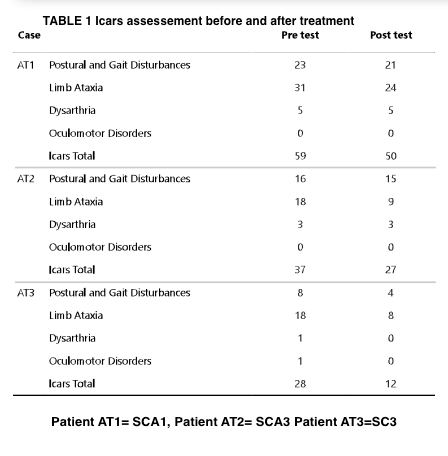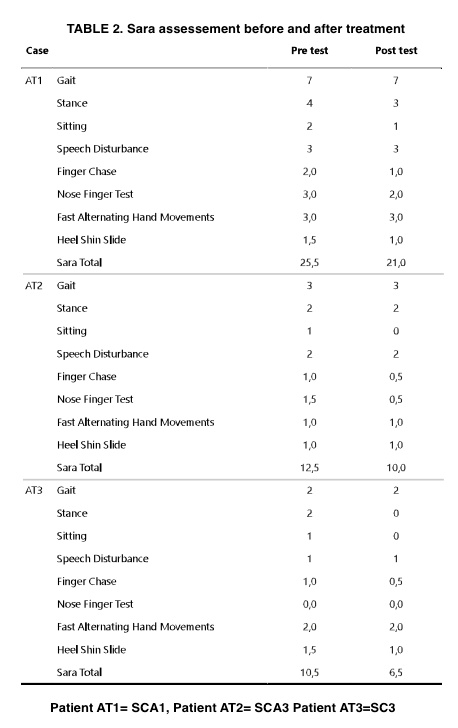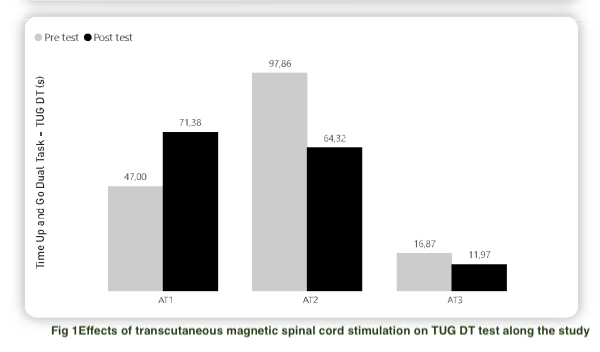Category: Ataxia
Objective: To investigate whether a 1-week treatment with repetitive trans-spinal magnetic stimulation (rTSMS) combined with kinesiotherapy could reduce motor and gait symptoms in patients with neurodegenerative ataxia.
Background: Neurodegenerative ataxias represent a heterogeneous group of movements disorders characterized by motor and cognitive disturbances, for which no effective treatment is currently available. Previous studies showed that rTSMS significant decreased gait disturbances in Parkinson diseases patients1,2,3, but its effects on ataxia is unknown.
Here, we investigated in a prospective, open-label, pilot study the efficacy of non-invasive magnetic stimulation of the spinal cord in tree patients with neurodegenerative ataxia, two of them with Spinocerebellar Ataxia type 3 (SCA3) and one with Spinocerebellar Ataxia type 1 (SCA1), who experienced motor and gait problems.
Method: A trial of repetitive trans-spinal magnetic stimulation (rTSMS) was performed at the level of the fifth thoracic vertebra. In addition, all participants underwent rehabilitation 5 days a week. The primary outcome was the change in scores Scale for the Assessment and Rating of Ataxia (SARA), International Cooperative Ataxia Rating Scale (ICARS) 1 week after intervention in the last day of stimulation. Secondary outcome measures included changes in gait speed in Timed Up ang Go Test, Timed UP ang Go Dual task, 10-m walking time). Each patient underwent a clinical evaluation before and after intervention.
Results: rTSMS combined with kinesiotherapy showed an improvement in performance all motor scores (Scale for the Assessment and Rating of Ataxia, International Cooperative Ataxia Rating Scale). 15% to 57 % improvement in Icars [table1] and 18 % to 38 % improvement in Sara [table2]. In gait performance (evaluated with Timed Up ang Go Test, Timed UP ang Go Dual task, 10-m walking time), we observed an improvement in two patients [figure1].
Conclusion: This pilot study suggests that a 1-week treatment with rTSMS combined with kinesiotherapy reduces symptoms in 3 patients with ataxia and might represent a promising future therapeutic and rehabilitative approach in patients with neurodegenerative ataxia. Large scale phase II trials are needed to test this hypothesis.
References: [1]Takao Mitsui,Yoshiharu Arii ,Koichiro Taniguchi ,Satoshi Tsutsumi ,Mika Takahara Masaru Mabuchi , Nichika Sumitomo, Mieko Matsuura, Yukiko Kuroda .Efficacy of repetitive trans‐spinal magnetic stimulation for patients with Parkinson’s disease: a randomised controlled trial. Neurotherapeutics. 2022 Jul;19(4):1273-1282
[2]de Souza CP, Dos Santos MGG, Hamani C, Fonoff ET. Spinal cord stimulation for gait dysfunction in Parkinson’s disease: essen- tial questions to discuss. Mov Disord. 2018;33:1828–9.
[3]Pinto de Souza C, Hamani C, Oliveira Souza C, Lopez Contreras WO, Dos Santos Ghilardi MG, Cury RG, Reis Barbosa E, Jacobsen Teixeira M, Talamoni Fonoff E. Spinal cord stimulation improves gait in patients with Parkinson’s disease previously treated with deep brain stimulation. Mov Disord 2017;32:278–82.
To cite this abstract in AMA style:
C. Souza, L. Lopes, J. Oliveira, S. Casagrande, C. Tanaka, E. Barbosa, R. Cury. Repetitive trans-spinal magnetic stimulation and kinesiotherapy could reduce motor and gait symptoms in patients with neurodegenerative ataxia? [abstract]. Mov Disord. 2023; 38 (suppl 1). https://www.mdsabstracts.org/abstract/repetitive-trans-spinal-magnetic-stimulation-and-kinesiotherapy-could-reduce-motor-and-gait-symptoms-in-patients-with-neurodegenerative-ataxia/. Accessed December 31, 2025.« Back to 2023 International Congress
MDS Abstracts - https://www.mdsabstracts.org/abstract/repetitive-trans-spinal-magnetic-stimulation-and-kinesiotherapy-could-reduce-motor-and-gait-symptoms-in-patients-with-neurodegenerative-ataxia/



